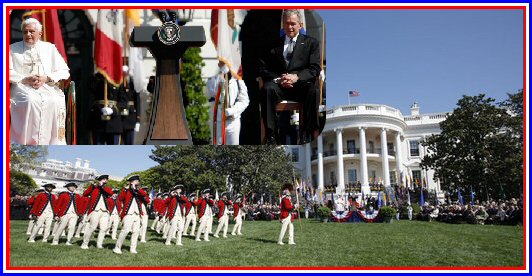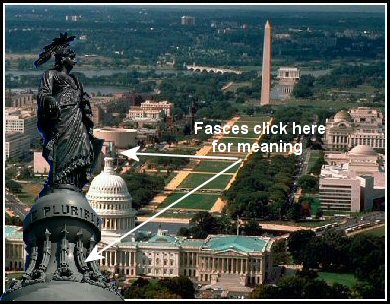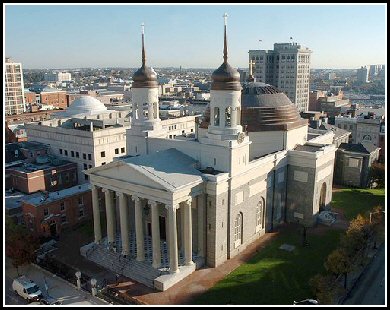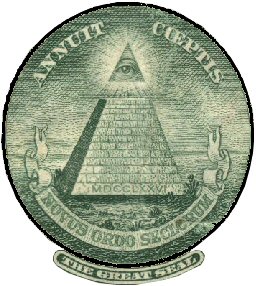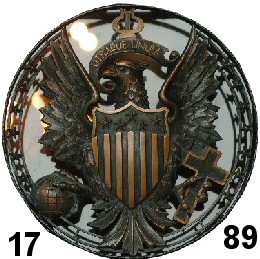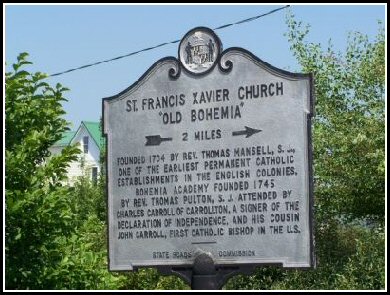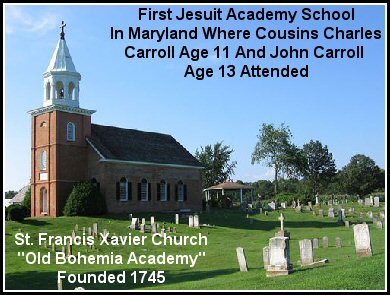
Tracking the Beast from the Synagogue to the Vatican to the USA!
Jesuit Zionism has taken the Protest out of Protestantism!
Pope Benedict XVI
Celebrates 200th Anniversary in America
April 15-20, 2008
Of the founding of the Archdiocese of Baltimore in Mary Land, And Dioceses of Boston, New York, Philadelphia and Louisville |
Pope
Benedict XVI Visit April 2008 Listen to internet radio
with Mystery
Babylon Radio on Blog Talk Radio
|
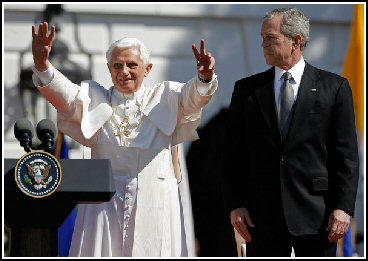
History happened April 16, 2008, when Pope Benedict XVI met with President Bush at the White House. Never before has such an event taken place. An event of “Tremendous religious significance”, CNN declared as it began. (CNN, 4-16-08). By the time his visit was over the Catholic media was in a swoon, and the Roman Church was ecstatic, euphoric, wildly energized. Pope Benedict repeatedly made it brazenly clear that he was celebrating in this visit to America the Jesuit John Carroll, first Roman Catholic bishop in America, and the establishment of the first American archdiocese in Baltimore, with its dioceses in Boston, New York, Philadelphia and Louisville. |
||||||||||||||
|
Why the Focus on the American Revolution?
|
||||||||||||||
|
||||||||||||||
|
A New Power Has Seized American Catholicism
|
||||||||||||||
|
Pope Benedict XVI came to America
to celebrate America's Takeover The Papacy, and the Jesuits in particular, had their own reasons, and purposes for wanting an American Revolution against Britain. British law forbade holding Masses. Rome wanted the colonies to break away, and declare religious liberty for all, including Rome, thus giving Rome freedom to operate in this powerful new emerging nation. The Protestants had their reasons for freedom of conscience, but the Jesuits had their reasons, too. In the Roman scheme, the “Utopian scheme” referred to by Benedict XVI, “We have our own Utopian scheme,” freedom must be granted for Rome to gain power. Once in power she denies freedom to all except herself. Of course, Rome always calls for freedom to obtain freedom for herself to gain power and control. Once she has obtained power, she denies freedom to all others. Benedict even spoke openly on worldwide television about how Britain had forbidden the Mass, but in America religious liberty was written into the US Constitution, giving Rome a free hand to conduct Masses and establish her power in America. A Short Reflection. 1. Rome
wanted the American colonies to break away
from Britain, so that Rome could have a free
hand in the colonies. This is clear from
what the pope said, as well as from history.
When I first started studying Rome's conception
of the American Revolution some years ago, it
seemed so fantastic that I had to table it for a
time. It seemed like it was just a little too
much. It was so radically different from the
Protestant conception of the American
Revolution, now fading in the history books. But
now I know that this fantastic plan of Rome,
conceived by the Jesuits prior to the American
Revolution, is true. The pope confirmed it with
his visit to America on April 16, 2008 at the
White House, before the bishops at the Crypt
Chapel in the Basilica of the Immaculate
Conception. Then the Mass at Yankee
Stadium was to celebrate the founding of the
Baltimore archdiocese in Mary Land 200 years
ago. Roman Catholic education also confirms it. 2. Rome
already had one colony, Mary Land. The pope
declared that he came to celebrate the
establishment of the diocese of Baltimore, in
Mary Land, 200 years ago. 3. The pope
came to celebrate America's first Roman
Catholic bishop, the Jesuit John Carroll. 4. Jesuit
John Carroll was entrusted with the task of
orchestrating the coming American Revolution
to accomplish Jesuit and Roman purposes for
America. 5. John
Carroll went to Rome from his teaching
post at the Jesuit University at Bruges,
arriving in Rome in the autumn of 1772, to be
appointed by the Black Pope, Lorenzo Ricci, to
the position of Prefect of the Sodality. 6. As Prefect of Sodality, Carroll's task was to organize laymen for “the Promotion of some form of social action.” This appointment happened four years before the Revolution. 7. Carroll was to be the Jesuits' cat's paw in the American colonies and in the American Revolution, to accomplish Rome's goals, to create a new nation that would ultimately be controlled by Rome. 8. Carroll traveled incognito with a dedicated Roman Catholic student, a nephew of the Duke of Norfolk, immersed in the Spiritual Exercises of the Jesuits, visiting heads of state all over Europe from the summer of 1771 to the spring of 1773. 9. In his incognito travels Jesuit John Carroll went out of his way to go to the Jesuit University at Tries, where there was a Latin document which the Jesuits apparently wanted to use as a blueprint for the takeover of the new American nation. 10. The pope made it clear that while he appreciated the US president's invitation to come to America and the White House, there was clearly another reason why he had come--the celebration of the 200th anniversary of the founding of America's first archdiocese--the archdiocese of Baltimore, in Mary Land, headed by the Jesuit John Carroll. John Carroll is the Jesuit champion of Roman Catholicism in early America. He founded the Jesuit Georgetown University. 11. The pope launched a repeated attack against the foundations of Protestantism, fiercely attacking the idea of "private religion" which, he said, destroys the soul. 12. The pope spoke of the need for "global solidarity" thus signaling that he is carrying forward the John Paul II vision of the papal New World Order. 13. At the
Crypt Chapel in the Basilica of the Immaculate
Conception, the pope revealed that Roman
Catholicism has not forgotten in the
slightest that while Masses
were banned in Britain, religious freedom was
written into the Constitution of America,
making it possible for Rome to move full steam
ahead here, establishing her power with the Masses,
universities, dioceses, etc. 14. The pope spoke of the importance of Sunday worship. Sunday is very dear to his heart as evidenced in his book, The Spirit of the Liturgy. 15. The patroness of America is Mary, the pope declared. Indeed, it was in Mary Land, in Baltimore, the Roman Catholic colony, where the first archdiocese was established by the Jesuit John Carroll. The Carroll family donated land named "Rome" for Washington, D.C. The pope came to celebrate the establishment of this diocese 200 years ago. |
||||||||||||||
|
The
Catholic Carroll Family in the
Revolution The Catholic Carroll family was one of the wealthiest American families alive. There were three Carroll sons--Daniel, John and their first cousin Charles. They all had been trained in Jesuit warfare at the Jesuit St. Omer's College in France. John, the Jesuit, became a teacher there. Charles studied law at the Jesuit College Louis-le-Grand in Paris, and was sent to study further at London's Inner Temple. "The mother of Daniel and John, Eleanor Darnall, claimed direct descent from the Calverts (Calvert was Lord Baltimore), the owning family of original Maryland. She had come into possession of much of the land that Daniel would transfer to the District of Columbia. Charles Carroll stood to inherit America's largest private estate; later, John Adams would label him America's richest citizen." Studies At St. Omer's Jesuit College in Europe Young
John
Carroll studied at Bohemian Manor, a secret
Jesuit academy just down the road, "run
secretly because of anti-Catholic laws
resulting from the abdication of Catholic
James II and the succession of Protestants
William and Mary to the British throne in
1689. The Penal Period in Maryland, which
would extend up to the American Revolution,
served the Black Papacy well by inclining
affluent Catholic families to send their sons
across the Atlantic to take the Jesuit ratio
studiorum at St. Omer's. Indeed, more
Americans went to St. Omer's College in the
eighteenth century than to Oxford and
Cambridge combined. (Geoffrey Holt, S.J., St.
Omers and Bruges Colleges, 159301773: A
Biographical Dictionary, London 1979) Jesuit John Carroll Flees St. Omer's At age 13 John Carroll traveled with his cousin Charles to attend school at the Jesuit St. Omer's. Daniel returned home from there to manage the family inheritance. In 1753 John Carroll entered the novitiate of the Jesuits at Watten in the Netherlands. In 1758, John returned to St. Omer's to teach, being ordained to the Jesuit priesthood in 1761. When John found out that "The Jesuit St. Omer's was about to be seized by the French government in preparation for the royal edict suppressing the Jesuits in France, he with other teachers and their pupils move to Bruges." Jesuits Rise to Secular Prominence When Disestablished in 1773
On July 21, 1773, Ganganelli, Clement
XIV abolished the Jesuits "for all eternity."
John Carroll "appraised it as the
'secularization' of the Society of Jesus.
Thousands of Jesuits now rose to secular
prominence throughout the western world, in
the arts, sciences, and government...Adam
Weishaupt, dismissed from the Jesuit college
at Ingolstadt, attracted the fiercer elements
of European Rosicrucian Freemasonry into a new
secret cult in Bavaria"-the Illuminati.
"Countless other members of the greatest
clandestine intelligence agency the world has
ever known, now secularized with the jeering
approval of its enemies, crossed the
Atlantic to help guide Americans through the
pains of becoming the first nation expressly
designed to be a Febronian, Bellarminian
democratic republican Church-State." Jesuit John Carroll
Escapes to England:
In October, 1773, about three months
after the suppression of the Jesuits,
"Austrian officials with drawn bayonets
descended upon the Jesuit College in
Burges-the officials were Austrian because
Bruges was under the jurisdiction of the
Austrian Government. They arrested John
Carroll and the rest of the college faculty
and students. Stripped of his possessions and
papers, Carroll was spared further humiliation
by the timely intercession of his erstwhile
traveling companion Charles Philippe
Stourton's cousin, Henry Howard Lord Arundell
of Wiltshire. The Catholic nobleman escorted
Carroll across the English Channel to
Wiltshire's lushly rolling hills. Carroll Organizes Catholics for Independence May, 1774, about a year before Lexington and Concord, which took place April 19, 1775, John Carroll Left Wardour Castle for Maryland. As John Carroll arrived in Maryland, it was the time frame of "Paul Revere's ride to Philadelphia bearing letters from the Boston Committee of Correspondence seeking aid from Charles Thompson's group in protesting the closing of Boston Harbor. From his mother's estate at Rock Creek, Carroll dealt with the aftermath of the Tea Act by exercising his 'secularized' priestly authority as Prefect of the Sodality. He integrated the Catholics of Maryland, Pennsylvania and northern Virginia into the movement for independence." Remember, that in England the Mass was forbidden. War Commissioner Charles Carroll "Charles Carroll was named
by the Annapolis Committee of Correspondence
to be a delegate to the First Continental
Congress." Clement XIV Dies; Cardinal Braschi and Ricci Plan Meanwhile, Pope Clement XIV died an agonizing death, poisoned by the Jesuits, dying September 22, 1774. Cardinal Giovanni Braschi, a very close associate of Ricci, the Black Pope, and also Apostolic Treasurer when Rothschild began serving the Catholic principality of Hesse-Hanover in 1769, Braschi ruled over the papacy while the conclave haggled over what to do about the Jesuits. Lorenzo Ricci, the Jesuit Superior General, was in detention at Castel Sant'Angelo, where "he could easily hop a tunnel carriage to the Vatican for cover meetings with the Virtual Pope." Braschi Becomes Pius VI Braschi, the Treasurer of the Apostolic Treasury, who takes over the Holy See's temporal rights business affairs, when a pope dies-was a creation of the Black Pope, Lorenzo Ricci, and the two were secretly allied for years. After nearly five months of confusion on February 15, 1775, Rome had a new pope-one acceptable to both sides of the Jesuit question. The new pope was Giovanni Braschi, Pope Pius VI. Countdown to Independence Things were moving
rapidly in America. February 9, 1775:
Parliament declares Massachusetts to be "in a
state of rebellion." March 23: Patrick Henry
delivers "GIVE
ME LIBERTY OR GIVE ME DEATH"
oration. April 19: Lexington and Concord.
Massachusetts Provincial Congress mobilized
13.600 colonial soldiers. Boston is under
siege for a year. Second
Continental
Congress Sends Franklin, February 15,
1776, the Second Continental Congress resolved
to send Benjamin Franklin, Samuel Chase and
Charles Carroll to Montreal "to promote or form
a union" with Canada against England. Jesuit
John
Carroll Moves Into On the way
back from Canada, Benjamin Franklin fell ill.
The Jesuit John Carroll escorted him to
Philadelphia. Franklin invited Carrol to move
in, and John Carroll moved into Franklin's home.
"Franklin acknowledged the fact in a letter
dated May 27, 1776, mentioning Mr.
Carroll's friendly assistance and tender care of
me." Daniel
Carroll
Provides Farm (Rome) "The land known today
as the District of Columbia bore the name 'Rome'
in 1663 property records; and the branch of the
Potomac River that bordered 'Rome' on the south
was called 'Tiber." Roman History and Roman Vision
And |
||||||||||||||
|
The
Return
to Traditional Catholicism It is arising storm, a perfect storm, a megastorm, and I sense and feel the rising in the wind. It's happening. The storm flags are flying straight out. Now. The thousands of rivulets from the supreme court, to Congress, to the White House, across the radio and TV, in the schools and churches, are all flowing together into a mighty river of Roman influence. The effect of tens of millions energized every day by the Roman Catholic talk show hosts, the energy of the Culture Wars, joining to work with "Protestants", are all coalescing. The work of the orders of Rome, from the Knights of Malta and Opus Dei working the intelligence agencies and the war against Fundamentalist Islam, to the Knights of Columbus and anti-abortion, to the Franciscan charismatic movement--a thousand strands are coming together. Rome's agents in the media, in Congress, in the Courts, in government, in academia, and millions pouring across the border--all are now having their effect. Even the pope was astonished at its power. Archbishops, bishops, priests, nuns, religious, are exulting as never, ever before. Rome is resurgent, her power will soon once again rule the world. Future of the Church in America Must Begin to Arise "Prophecy foretells a restoration of her power." I saw one of his heads as it were wounded to death; and his deadly wound was healed: and all the world wondered after the beast."
This is why there
was a Revolutionary marching band at the White
House parading before the pope and the
president on April 16, 2008. This is why the
pope repeatedly spoke in glowing terms of John
Carroll. This is Rome's version of
Now
you know at least a little bit of the
rest of the story.The American Revolution-its Catholic component.
|
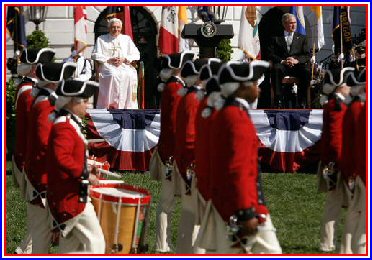
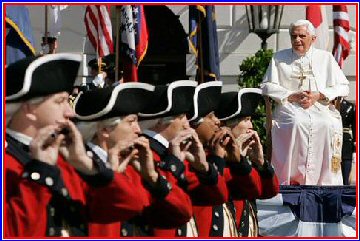
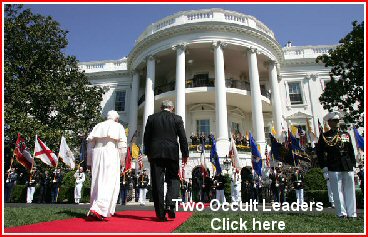
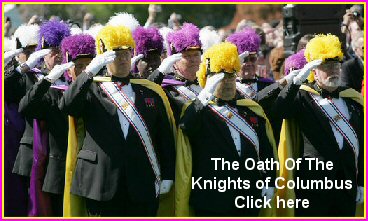
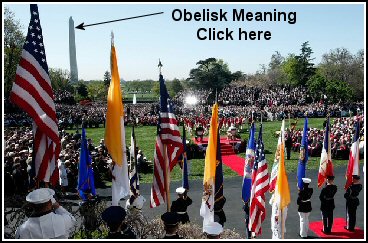
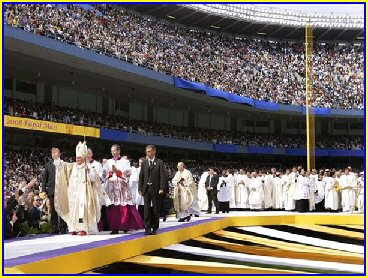 This was not
just another papal visit to America. A new power
has seized Roman Catholicism in America, a power
that even amazed Pope Benedict XVI. Never have
we ever seen such an out poring of enthusiasm
conveyed by television as what took place at
Yankee Stadium...Rome is mightily on the
march...The pope gathered up the whole history
of Roman Catholicism in America, since the
Revolution of 1776 in his mission to
America...for a purpose. He is undoubtedly the
most intelligent pope the papacy has had in a
while. His incredible stamina for 81 years of
age sustained him in an absolute whirlwind of
intense meetings in a densely packed schedule.
His intellectual focus is spurring on American
Catholicism. More people crowd St. Peter's to hear
what this pope has to say , than thronged it to
This was not
just another papal visit to America. A new power
has seized Roman Catholicism in America, a power
that even amazed Pope Benedict XVI. Never have
we ever seen such an out poring of enthusiasm
conveyed by television as what took place at
Yankee Stadium...Rome is mightily on the
march...The pope gathered up the whole history
of Roman Catholicism in America, since the
Revolution of 1776 in his mission to
America...for a purpose. He is undoubtedly the
most intelligent pope the papacy has had in a
while. His incredible stamina for 81 years of
age sustained him in an absolute whirlwind of
intense meetings in a densely packed schedule.
His intellectual focus is spurring on American
Catholicism. More people crowd St. Peter's to hear
what this pope has to say , than thronged it to
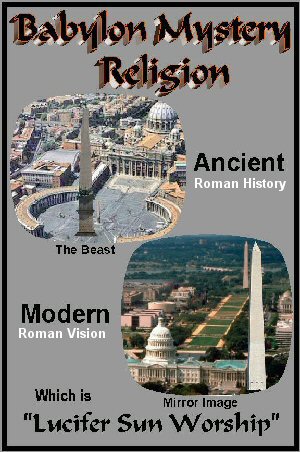 With Daniel
Carroll providing land for the Capitol,
with Charles Carroll as War
Commissioner, controlling all the
executive duties of the military department,
with its ammunition supplies of cannon balls,
shot, kettles, spikes and nails to the army,
with John Carroll an intimate friend
of Franklin, even living in Franklin's house,
and District of Columbia donor and Capitol
Commissioner Daniel Carroll
close to
With Daniel
Carroll providing land for the Capitol,
with Charles Carroll as War
Commissioner, controlling all the
executive duties of the military department,
with its ammunition supplies of cannon balls,
shot, kettles, spikes and nails to the army,
with John Carroll an intimate friend
of Franklin, even living in Franklin's house,
and District of Columbia donor and Capitol
Commissioner Daniel Carroll
close to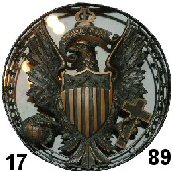 Washington, with
John Carroll establishing Jesuit
Georgetown University, whose seal
proclaims a Roman eagle grasping the world
and the cross, State and Roman Catholic
Church with a banner in its beak, "Utraque
Unum,"-"Both Together,"
with the mayor of the District of Columbia Carroll's
nephew Robert Brent, it is not hard to
see the proud Roman Catholic component of
the American Revolution...and the Roman
Catholic vision of a land where Roman
Catholicism would be given the freedom to
expand to the maximum...to take over the
nation...and the world.
Washington, with
John Carroll establishing Jesuit
Georgetown University, whose seal
proclaims a Roman eagle grasping the world
and the cross, State and Roman Catholic
Church with a banner in its beak, "Utraque
Unum,"-"Both Together,"
with the mayor of the District of Columbia Carroll's
nephew Robert Brent, it is not hard to
see the proud Roman Catholic component of
the American Revolution...and the Roman
Catholic vision of a land where Roman
Catholicism would be given the freedom to
expand to the maximum...to take over the
nation...and the world.